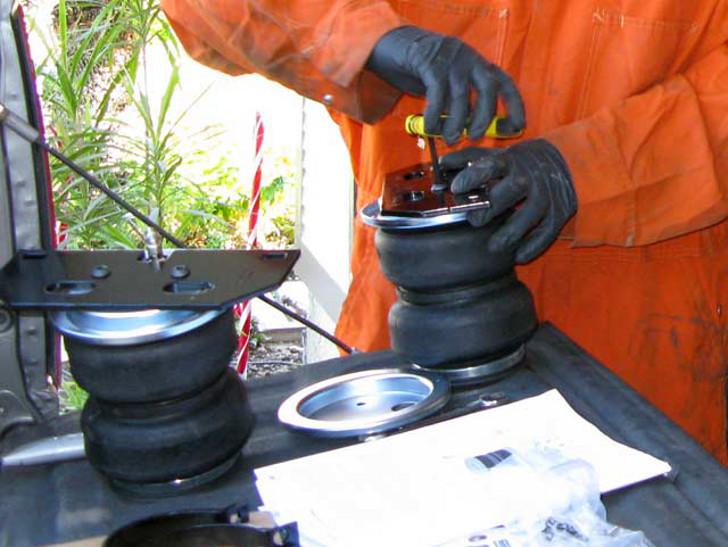How Much Does it Cost to Install Airbags?
By Sebastian Orellana
Updated Feb 18, 2024

A lot of essential parts of a vehicle are meant to keep the driver safe from the dangers of the road. Things like seatbelts, turn signals, or rearview mirrors are all essential, but nothing is more lifesaving than airbags. You may not see them, but these safety cushions can make the difference between life and death in a collision.
Table of Contents
This post will discuss the cost of installing airbags and the factors that can influence the price. We will also examine the safety benefits of airbags and the types of vehicles that can benefit the most.
What Are Airbags?

Airbags are life-saving devices installed in vehicles to reduce the impact of collisions and improve the chances of survival for drivers and passengers. Although airbags are a necessary safety feature, installing them can be costly.
READ: Best Donk Suspension
Cost of Installation
The cost of installing airbags can vary significantly depending on the type of vehicle and the complexity of the installation process. Generally speaking, the cost of airbag installation ranges from approximately $400 to $2,000. The most expensive installations involve luxury vehicles, costing up to $3,000.
Factors Influencing Installation Costs
Several factors can influence the cost of airbag installation. The type of vehicle, the complexity of the installation process, and the number of airbags being installed are all important considerations. Additionally, the cost of labor, the availability of parts, and the cost of the airbags can influence the final price.
Safety Benefits

The primary benefit of airbags is the improved safety they offer. Airbags have been proven to reduce the severity of injuries in a collision. Also, airbags can help protect against other common injury causes, such as rollovers and side-impact collisions.
Computer-Controlled Deployment
Airbags are triggered by a computer-controlled system designed to detect a crash and deploy the airbag. This system can sense the impact's severity and deploy the airbag with the appropriate force to help protect occupants.
Life-Saving Protection
Airbags provide life-saving protection against severe injuries like broken bones and head trauma. In the event of a crash, the airbag will deploy to cushion the impact and protect occupants from the force of the collision.
Reduction of Injuries
Airbags are designed to reduce the severity of injuries in a crash. By cushioning the impact of a crash, airbags can help to minimize the risk of serious injury.
Increased Visibility
Airbags can provide increased visibility during a crash. By deploying in front of the driver, airbags can help improve driver visibility and possibly help avoid further collisions.
Seat Belt Integration
Airbags are designed to work with seat belts to provide additional protection during a crash. Seat belts help to secure passengers in the vehicle, while airbags offer extra security by cushioning the impact.
Reduction of Fatalities
Airbags have been proven to reduce the risk of fatalities in a crash. By cushioning the impact of a collision and providing life-saving protection, airbags can help to reduce the risk of severe injury or death.
Cost Savings
Airbags are a cost-effective way to protect occupants during a crash. By reducing the severity of injuries, airbags can help to save money on medical bills and other costs associated with an impact.
Improved Safety Ratings
Vehicles equipped with airbags are often given higher safety ratings. By providing additional protection in the event of a crash, airbags can help to improve a vehicle's safety rating and make it a more attractive option for drivers.
Types of Vehicles

Airbags are most commonly installed in passenger vehicles, such as cars, SUVs, and vans. However, airbags can also be installed in large commercial vehicles, such as buses and trucks. Airbags are also available for motorcycles and other types of recreational vehicles.
Installation Process
The installation process for airbags can vary depending on the type of vehicle. Generally, the process involves removing the old airbag components, installing the new components, and connecting the system to the car’s electrical system. A certified technician typically does the installation process.
Components
Airbags comprise several components, including the airbag, sensors, inflator, and control module. The airbag is the most critical component, as it is responsible for cushioning the impact of a collision. The other components work together to ensure the airbag deploys appropriately during a crash.
Safety Regulations
Airbags are subject to safety regulations in many countries. These regulations require that the airbags meet specific standards for safety and performance. Additionally, the rules require that the airbags be adequately installed and maintained to ensure their effectiveness.
READ: What Does OBS Chevy Mean?
Installation Techniques

Several techniques can be used to ensure proper airbag installation. These techniques include following the manufacturer’s instructions, testing the system after installation, and inspecting the components for defects. Additionally, it is essential to understand airbag safety regulations to ensure that the system meets all applicable standards.
Replacement Parts
Sometimes, the airbag components may need to be replaced due to age or wear. The cost of the replacement parts will vary depending on the type of vehicle and the specific part being replaced. The labor cost for replacing the parts can also be a factor.
Maintenance
Airbags require regular maintenance to ensure that they are in proper working condition. This includes inspecting the components, testing the system, and replacing worn or damaged parts. Additionally, it is essential to ensure that the airbags are appropriately calibrated to deploy correctly in the event of a crash.
READ: How Much Horsepower Does A 454 Engine Have?
Conclusion
Installing airbags in a vehicle can be a costly endeavor. However, the expense is well worth it in terms of the safety benefits that airbags provide. By understanding the cost of installation, the factors that influence the cost, and the safety benefits of airbags, drivers can make an informed decision about whether or not to install them in their vehicles.
